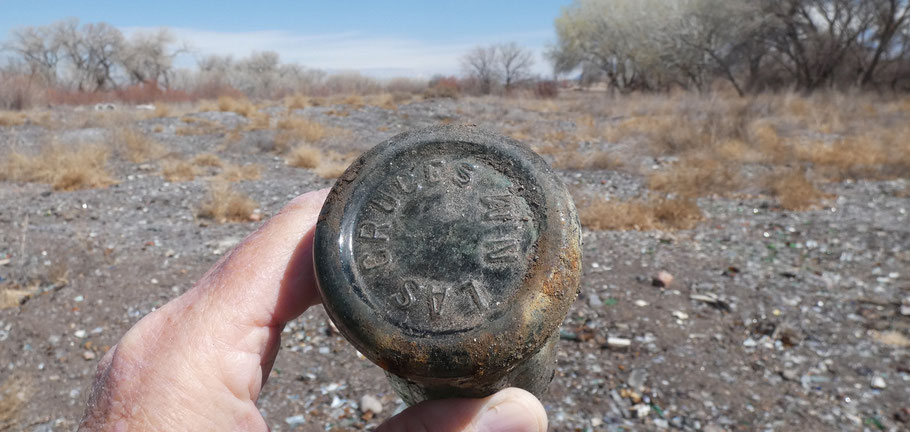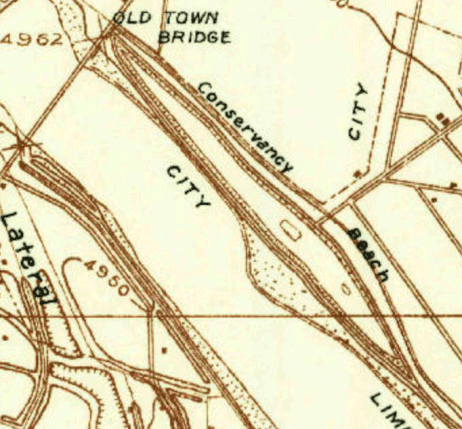Albuquerque's Glass Garden in the Rio Grande Bosque

Here’s a ramble unlike any other on this web site. I’ll describe the destination first, will present conflicting information on its history next, and will finish with the directions. For more context, click on links. To add to your experience, bundle this half-day outing with a chile fix, courtesy of the locally renowned Barelas Coffee House.
The Glass Garden is a garbage dump from before the local use of sanitary landfills. The garbage was repeatedly burned, a common measure back then (it eliminated the stink of rotting organic material and kept down flies). The most recognizable contents are the items that resist repeated burning and decades in the ground: shards of glass and china. There is metal, but mostly as unrecognizable corroded lumps.
You won't find any treasures here; the surviving items are fairly recent (mid-1900s) and mostly in pieces. The glass containers that managed to survive intact have deteriorated (burying and then exposing glass will do that). Instead, content yourself with finding items such as crockery bits with logos and the bottoms of old Coca-Cola bottles.
For years, local artists have gone to this spot to find items to use in their projects. They’re the ones who came up with the name “Glass Garden” (I learned about it from two of those local artists). Currently (March 2021), a large hole is evidence of (probably futile) bottle-hunting. Having said all that, I need to point out that the Glass Garden is an archaeological site on public land, and part of a state park—so it’s a crime to dig there or remove items. Wander around and satisfy your curiosity, but leave behind everything you see.

Among the things you’ll find are shards of hotel china with logos containing the word Minimax. New Mexico native Conrad Hilton coined the word to summarize the slogan for his new hotel chain: “Minimum Rates—Maximum Service.” Hilton Hotels used Minimax china from 1925 until 1946, when the hotel chain changed its logo and slogan. These bits of crockery no doubt originated in Conrad Hilton's Albuquerque hotel, now the Hotel Andaluz.
There are at least two versions of the history of the Glass Garden. First I'll present the legend that was passed down to me. After that I'll provide a more prosaic version.
The following is true either way, but mostly relevant to the legend. Before the realignment of Route 66 in 1937, westbound travelers drove to Santa Fe, then down through Albuquerque to Los Lunas, then westward from there. Whichever direction they drove, the motorists usually stayed the night in Santa Fe or Los Lunas, passing through the Duke City. In 1937, with a lot of help from Governor Clyde Tingley, the route was realigned to go east-west through Albuquerque (along Central Avenue). Santa Fe and Los Lunas having been bypassed, motorists were now more inclined to stay in (and spend money in) Albuquerque. Politics aside, the new alignment was an improvement: it reduced the drive time through New Mexico by several hours.
Tingley's support is easily explained. He was from Albuquerque and from 1925 to 1935 had served as the mayor (albeit under a different title). By the way, the Wikipedia articles on the Route 66 and on Governor Arthur T. Hannett claim that Hannett, not Tingley, was the primary force behind the 1937 realignment. That information must be incorrect. Hannett ended his governorship a decade before the realignment took place.
Now for the legendary part. Pre-realignment, Albuquerque supposedly had a garbage dump (possibly an informal one) next to the Rio Grande just south of Central Avenue. That had been an out-of-the way place, but now motorists following Route 66 would drive past the dump. Besides, city leaders wanted to induce motorists to linger in the Duke City, to boost the numbers of meals consumed and motel rooms rented. Albuquerque therefore converted the former dump area into Tingley Beach, a swimming hole where motorists would pause to seek relief from the hot New Mexico summers. (In the 1930s air conditioning still rare in buildings, and automobile air conditioning even rarer.) Due at least in part to the water-borne transmission of polio, Tingley Beach was later converted from a swimming hole to fishing ponds. But meanwhile, of course, the city needed to move that garbage somewhere. Hence the Glass Garden.
Since this legend about the Glass Garden involves the change in alignment of Route 66, you might wish to know that my driving directions take you along a bit of the older alignment. Before 1937, Route 66 went through downtown Albuquerque along what is now Fourth Street. At what is now Avenida Dolores Huerta, the southbound route turned right (west), crossed the Rio Grande, and then turned left (south) onto Isleta Boulevard. To maximize your Route 66 fix, approach the downtown area on Central Avenue (the newer alignment) and turn south onto Fourth Street (the older one).

Now for a more boring version of the story. A City of Albuquerque web page lists the Glass Garden as the Closed Old River Landfill and dates it from the 1920s to the 1940s. Moreover, a city map of former landfills doesn't show any dumping at Tingley Beach. Also, the map segment shown above—surveyed and published in 1934—shows a "Conservancy Beach" in place, three years before Route 66 was realigned. (The name no doubt refers to the Middle Rio Grande Conservancy District, which built the levees that bracket Tingley Beach.) So most likely the Glass Garden was just one of many old garbage dumps in the area, with no special connection to Route 66, Tingley Beach, Clyde Tingley, and New Mexico politics.
The city web pages I just cited do include a comforting bit of information: monitoring wells at the Glass Garden showed no evidence of groundwater contamination.

At long last, the directions. From the intersection of I-25 and I-40 (“the Big I”), head south on I-25 and exit at Avenida César Chávez (NM 314). Head west. Once you’re over the railroad tracks, the street name changes to Avenida Dolores Huerta (former Bridge Boulevard). Just before you cross the Rio Grande, turn left into the parking lot of the National Hispanic Cultural Center (NHCC). Park in the northwest corner of the lot, cross to the west side of the Albuquerque Riverside Drain, and wander south between the river and the east side levee.
A single broad path snakes through this part of the Bosque, with multiple narrower paths (including to the river’s edge) branching off it. Roughly a mile south (as the burro trudges) from where you parked, you’ll encounter the Glass Garden. The main path south skirts it, so here’s the approximate center: 35 deg. 3.475 min. N, 106 deg. 39.408 min. W.
The homeless people who camp by the river seem especially common in this stretch of the Bosque. They’ve always left me alone, and seem to want only to be left alone themselves. (I feel far greater danger from the mountain bikers who come tearing around corners on narrow paths.) But if their presence would make you nervous, it’s best to avoid this ramble or to do it with friends. Another less-scary option is to walk on top of the levee at the edge of the Bosque (but you’ll lose that in-the-woods feeling you get closer to the river).
You can also visit the Glass Garden without the two-mile ramble. To do so, drive south on Fourth Street (NM 303) from the NHCC. The street soon turns left (east), becoming Southern Avenue, then dead-ends at Second Street. Now drive south on Second Street. Ninety meters past the south end of Barelas Railroad Park, at 35 deg. 3.566 min. N, 106 deg. 39.204 min. W, turn right into a gap between two fenced businesses. As soon as you do, park and head west, crossing the Barr Canal and Albuquerque Riverside Drain. Once across, head southwest. In about 100 meters you’ll encounter the Glass Garden.
